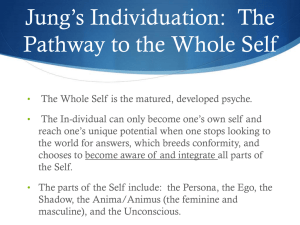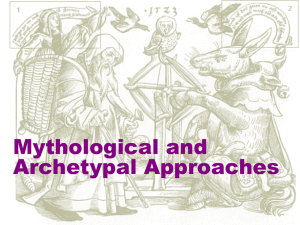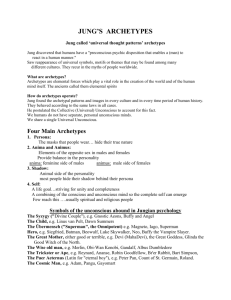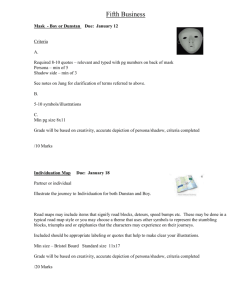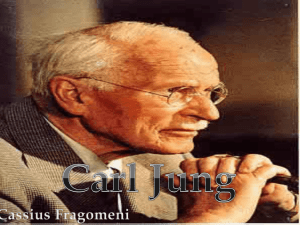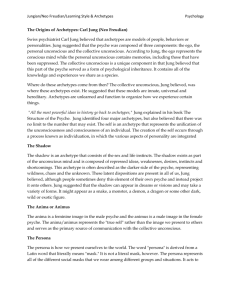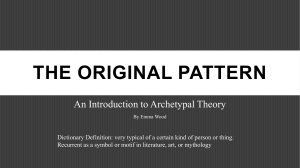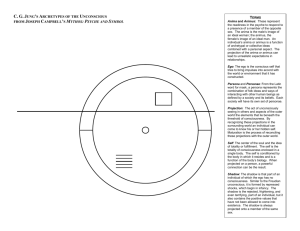Jung PPT Notes
advertisement
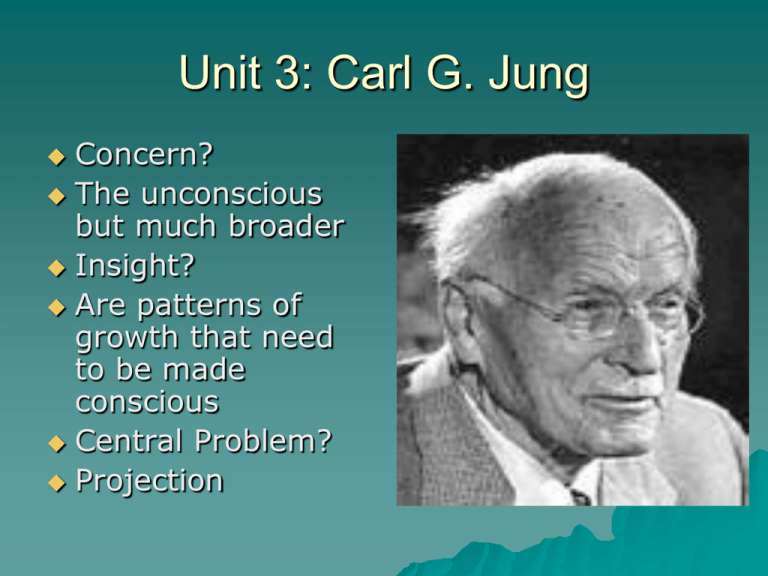
Unit 3: Carl G. Jung Concern? The unconscious but much broader Insight? Are patterns of growth that need to be made conscious Central Problem? Projection Once unconscious want to become conscious it is projected onto world and others: unconscious evil within is projected onto others Jungian Therapy? Making these patterns of growth conscious Where is religion? In religious experience Jung: We have to become conscious of the Imago Dei within if we are become a whole (Holy?) Self Hugely influential in contemporary spirituality 5 Things about Jung 1. The Psyche (and Unconscious) is real: rejects Western concept of Tabula Rasa 2. Passionately concerned with experience: inner life (dreams) most important 3. Many interpretations: almost a religion: take what you want 4. Focused on second half of life (35+) 5. Is very religious (untraditionally): God very real for him 1st Reading: Bio Questions What do you think Jung meant by his “personal myth”? Does a beautiful sunset need to be proved? Do you think religious needs are more important than sexual needs? Do you believe the universe is full of meaning, that we are surrounded by unseen powers? Why, why not? Do you view life more as a problem to be solved or a mystery to be lived? Jung, Freud, and James An historic meeting at Clarkson College, RI of Freud, Jung and William James (front center) Jung Quotes “Our heart glows, and secret unrest gnaws at the root of our being. Dealing with the unconscious has become a question of life for us”. - Carl Jung “Masses are always breeding grounds of psychic epidemics” “Who looks outside, dreams; who looks inside, awakes” Quotes continued “Everything that irritates us about others can lead us to an understanding of ourselves” “It all depends on how we look at things, and not how they are in themselves” “Knowing your own darkness is the best method for dealing with the darknesses of other people” Theory of Personality (The Self) How is the Self different from Ego? Is it scientific? A philosophical, religious postulate? Jung: self is unifying, integrating center of consciousness Structure of Personality The Psychic system: – Ego, personal unconscious, collective unconscious – Functions: thinking, feeling, sensing, intuition – Attitudes: introversion, extroversion Goal? Wholeness: a state of balance Complexes and Archetypes What are complexes? – Group of emotions, behaviors linked together How identified? Difference from archetypes? How do complexes and archetypes influence our behavior? What, according to Jung is the ultimate function of consciousness? Archetypes From the Greek: “primary imprint” Forms of being human: “outlines” filled in through experience What it means to be human: parallel to instincts As many archetypes as there are ways to be human Archetypes for mother, father, little boy, little girl, wise old woman, wise old man Core Concept of Individuation Individuation: process of becoming a Whole Self Task of going beyond individuality and individual consciousness and rediscovering one’s unity with all humanity: involves incorporating the collective unconscious Fundamentally religious process 3 Stage Pattern of Individuation 1) Unconscious unity: the infant’s state before individual consciousness 2) Individual consciousness: distinguishing between self and others; male and female, good and evil: a tension of opposites (task of first half of life) 3) Conscious Unity: reuniting these “opposites” to state of unity: involves incorporating unconscious life into our conscious life Process of Individuation takes place primarily during the second half of life Assumes the more the unconsciousness becomes conscious, the more whole one becomes is a process (journey) towards wholeness (and holiness); is always a process of reconciling opposites ego has to be clearly formed (primary task of adolescence and young adulthood): in terms of competency and responsibility, means taking on positive roles in the community -if ego not strong, can be disastrous; can be taken over by archetypes (shadow) Main Opposites Conscious-unconscious; male-female; young-old; ego-Self; persona-shadow; anima-animus Shadow: – all the ego has repressed in order that you can adapt to environment, society – in many ways is opposite of persona Persona: – Mask we present to outside – develops by repressing shadow Projection: whatever we allow to remain unconscious in ourselves (shadow) tends to be projected onto those around us Level 1: Consciousness: Ego, Persona, Shadow Ego: center of consciousness: – relates to reality – Thinking “I” – Has to be built up during first half of life Persona: – Public “Face”: mask of roles we can put on and take off in society – Danger of persona taking over ego: prevents further growth from occurring – Develops through repression of shadow – Individuation requires that ego become separated from persona Projection of Shadow Projection: changes the world into a replica of one’s “Unknown Face”: only that which we do not accept in ourselves do we find impossible to live with in others Projection of Shadow cont the shadow threatens ego; when repressed (and seen in others), it produces intense hatred and anger to pretend shadow does not exist is to give it strength people not in touch with shadow more likely to be manipulated and influenced by it The Feminine and Masculine What is the ‘contrasexual’ side of one’s personality and where, according to Jung, does it often go? What are the two opposite archetypes that represent these two aspects of human gender? Level 2: Anima and Animus according to Jung, everyone has qualities of the opposite sex we are all really male-female anima: the female side of male animus: the male side of female Once persona is held lightly enough, anima and animus want to become conscious Just as the outward face of the psyche is the persona, the inward Anima and Animus growing up, we all spend a lot of energy appearing to be the proper sex; for male, have to be ALL MALE; for female, ALL FEMALE; (obviously this has changed in contemporary culture but basic thrust of argument seems) Anima and Animus male and female sexuality largely a product of particular cultures Both anima/animus are archetypes: patterns of being, of understanding and perceiving the opposite sex Anima/Animus continued if men cannot deal with their anima, they get moody, for women, they get opinionated generally, anima of man fights with animus of woman when anima of man cannot become conscious (remains repressed and hidden), it behaves like an undeveloped, adolescent girl: pouts, moody when animus of women is not made conscious, it becomes aggressive, opinionated (like immature adolescent male) need to work on making both conscious if wholeness is to be reached Third Level: Self, or God-Image cannot be dealt with unless first and second levels have been dealt with Self: the most real part of person (Divine, our True Self that faces God) the organizing principle of the psyche It is the Principle of unification of all archetypes because it draws to itself and harmonizes the others Self draws others to wholeness Goal of individuation is the Self is the archetype of Wholeness (Holiness) Level 3 continued *At depth of self we are the image and likeness of God *not possible to realize self without having some kind of experience of God for Jung: whatever reveals the self reveals God Christ: Symbol of Fully Individuated Self For Jung, Christ unifies the human and Divine The Christian message is supposed to be a symbol of individuation, of Divine Wholeness this is found in the Beatitudes: described as a sort of handbook for individuation Christ as Individuated Self cont believed focus of religions all wrong: should be on the experience of the God-Image; instead it was on creeds and dogmas Creeds and Dogmas should be guides that point the way to personal religious experience; instead, too often, the creeds have become the focus
